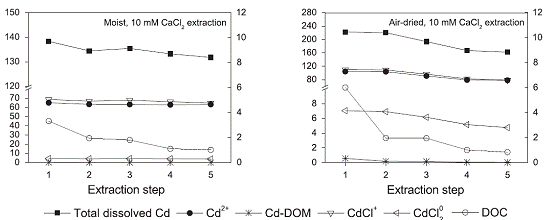
Air-drying of soil samples is known to increase the exchangeable fraction of cadmium (Cd) in soil. Liming, on the other hand, reduces bioavailability of heavy metals in soil by metal hydrolysis reactions and/or co precipitation with carbonate. However, due attention has not been paid to desorption and mobilization of Cd from air-dried and limed soils at realistic ionic strengths.
 |
|
Fig. 4. Total dissolved Cd concentrations and chemical speciation in the extracts from Takada L30 soil (limed, contaminated with 30 mg-Cd kg-1) during repeated washing. Average values (with coefficient of variation less than 5%) are presented for duplicate measurements. (Image by IMHE) |
The research achievements show that the size of exchangeable Cd in contaminated soils is prone to change upon drying and liming, and that the potentially desorbable Cd is only slowly mobilized under ionic strength conditions prevailing in the field.
TANG Xiangyu et al. Air-drying and liming effects on exchangeable cadmium mobilization in contaminated soils: A repeated batch extraction study. Geoderma(2011) 161: 18–29.

86-10-68597521 (day)
86-10-68597289 (night)

52 Sanlihe Rd., Xicheng District,
Beijing, China (100864)

